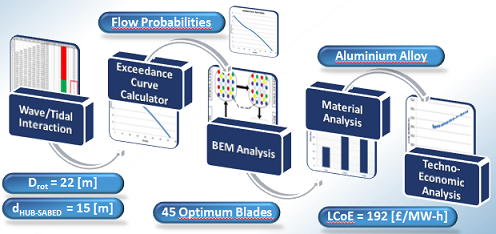Methodology for a Decision Support Tool for a Tidal Stream Device
MSc Sustainable Engineering: Offshore Renewable Energy


Conclusions
The results obtained from the tools, which were tested on the site of Mull of Kintyre, verified the compactness, reliability, and efficiency of the methodology, proving that it can help to decide whether a further detailed analysis of a tidal stream energy project in the user-defined site is worthwhile.

Result for Mull of Kintyre
Wave/Tidal Interaction Tool
One of the major advantages of this tool is the ability to quickly reject sites which should not be explored anymore. This reduces the time spent in site feasibility studies and eliminates the need for expensive long term site testing. The ability to be able to narrow down site quickly within one programme allows more areas to be explored.In conjunction with the exceedance tool this provides a first insight into site potential. The ability to change site data easily and obtain maximum diameter and exceedance curves for sites quickly allow multiple areas to be evaluated before making a decision to progress to the Blade Element Momentum.
Exceedance Curve Calculator
This tool gives a good first estimate of the tidal conditions at a site over time. It is most useful when comparing the exceedance curves of two different tidal sites. The tool outputs are used for later design programs, such as BEM, where it is important in calculating power output which is linked to the revenue and thus profitability of a site.Blade Element Momentum Analysis Software
The addition of the Genetic Algorithm of Matlab to the Blade Element Momentum theory allows the calculation of very meaningful and useful results from this tool. Since HARP_Opt is a state-of-art tool, every result that is obtained is a big step forward in the design of Tidal Stream turbines.We have carefully read the Matlab code of the application (which comprises close to 50,000 lines of code) and it has allowed us to obtain different Pareto optimum blades for different materials and rotor diameters, which we have further analyzed with our Techno-Economic tool.
All in all, the extraordinary challenge of using such a complex tool is more than rewarded by the importance of the results and their usefulness for obtaining the optimum Chord, Pre-Twist and Thickness along the length of the blade in order to maximize the Annual Energy Production while keeping the mass as low as possible.
Material Analysis Tool
In summary, the materials tool allows an insight to the reliability and durability of the blade root over the design life. This has important implications in the economics of the turbine design in terms of whether the blade root can withstand the extreme operating conditions over the extended life of operation. A fuller analysis evaluating all parts of the hydrofoil is recommended as well as enhancing the time resolution of the analysis in future work. However the above is a framework which could be developed to incorporate these aspects in the analysis in the future. Above all, the tool achieved the original aim to quantify the effect of the varying loading profile on the design life of the blade root.Techno-economical Analysis Tool
This tool is useful at the scoping stage since it allows obtaining quick and clear economic parameters for the desired Tidal Stream device.Once the previous tools have provided the required inputs and generated the sets of blade configurations (with their associated Annual Energy Production and Mass), it is required to determine which one of the different materials and blade geometries (Chord, Pre-Twist and Thickness) provide the lowest Levelised Cost of Energy.
Furthermore, the possibility of a having a quick approximation to the CAPEX and OPEX of the project, together with an estimated cash flow over the duration of the project, make this easy-to-use tool a very useful and interesting resource. Additionally, the discount rate is incorporated to make the calculations more accurate.